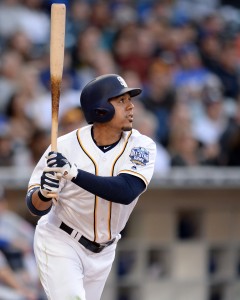After 12 Major League seasons, Gerardo Parra has decided to retire, as reported by MASNsports.com’s Dan Kolko during today’s broadcast. Parra will move into a new role as a special assistant in the Nationals front office.
Parra (who celebrated his 35th birthday two days ago) had signed a minor league deal with the Nats in Spring Training, but opted against a Triple-A assignment after not making the Opening Day roster. He’ll now call it a career after 1519 MLB games spread over 12 seasons with the Diamondbacks, Brewers, Orioles, Rockies, Giants, and Nationals, plus 47 games with NPB’s Yomiuri Giants in 2020. For his big league career, Parra batted .275/.322/.403 with 90 home runs over 5290 plate appearances.
An international signing for the D’Backs in 2004, Parra played his first five-plus MLB seasons in Arizona, establishing himself as one of the game’s best defensive outfielders. Parra won two Gold Gloves and a Fielding Bible Award during his time with the D’Backs, and also showed some occasional pop at the plate.
This production (particularly against right-handed pitching) helped Parra keep getting chances after his glovework started to decline. He scored a three-year, $27.5MM free agent deal from Colorado prior to the 2016 season, and while his own performance didn’t quite live up to expectations, Parra at least helped the Rox reach the postseason in both 2017 and 2018.
After signing with the Giants in the 2018-19 offseason, Parra didn’t last long in San Francisco, and caught on with the Nationals in May 2019. That set the table for probably the most memorable moments of Parra’s career, as he quickly became a Washington fan favorite after adopting “Baby Shark” (his young daughter’s favorite song) as his walk-up music.
More importantly, Parra became a clubhouse leader for a Nats team that went onto win the World Series. While he only hit a modest .250/.300/.447 over 204 PA for Washington during the regular season, and then made only seven total PA during the playoffs, Parra’s leadership was widely credited as a key reason why the Nationals were able to turn their season around after an ugly start in the first two months. Parra played in Japan in 2020, and then made one final encore run with the Nats in 2021, playing what would end up being his final 53 Major League games.
We at MLB Trade Rumors congratulate Parra on a tremendous career, and we wish him all the best in his new front office role.
 Jay, 37, was a second round pick of the Cardinals in 2006 and then made his MLB debut in 2010. He immediately hit the ground running with the contact-oriented approach that would be a trademark of his career. He hit .300/.359/.422, walking in 7.4% of his plate appearances and striking out just 15.5% of the time. That production amounted to a 116 wRC+, or 16% above league average. The next year, he put up a similar line of .297/.344/.424, 115 wRC+, helping the Cardinals qualify for the postseason and eventually win the 2011 World Series.
Jay, 37, was a second round pick of the Cardinals in 2006 and then made his MLB debut in 2010. He immediately hit the ground running with the contact-oriented approach that would be a trademark of his career. He hit .300/.359/.422, walking in 7.4% of his plate appearances and striking out just 15.5% of the time. That production amounted to a 116 wRC+, or 16% above league average. The next year, he put up a similar line of .297/.344/.424, 115 wRC+, helping the Cardinals qualify for the postseason and eventually win the 2011 World Series.